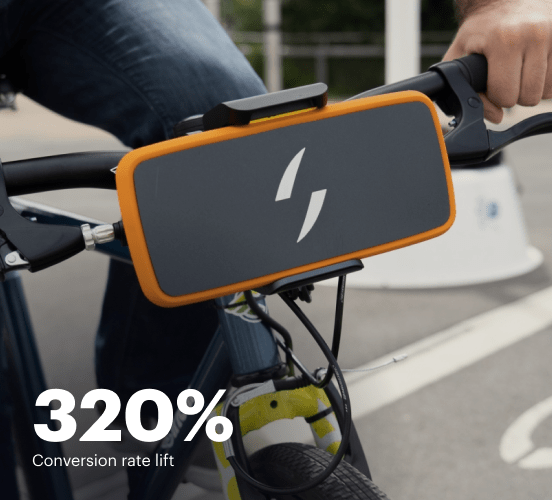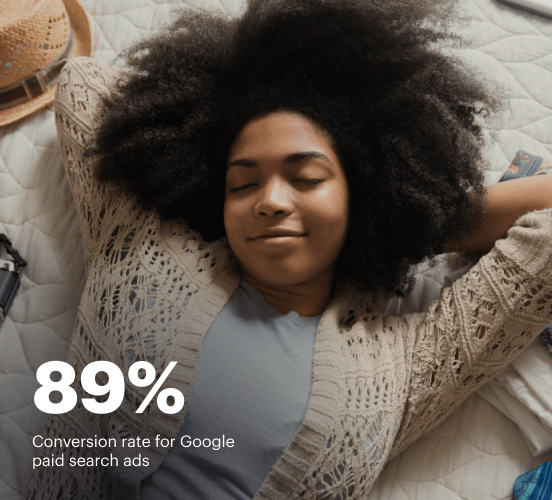How Canva vs. Elementor vs. Instapage stack up against each other
Compare Instapage with Canva and Elementor to create high-converting landing pages. With personalization, optimization, and collaboration tools, Instapage helps you deliver experiences that drive results.
Get startedSee how Instapage stacks up against the competition
| Feature | Instapage | Other builders |
| Drag-and-Drop Tools | ||
| Conversion-optimized templates | ||
| Manual and AI-powered A/B Tests | ||
| AI content suggestions | ||
| Popups and sticky bars | ||
| Canvas and grid blocks | ||
| Reusable and global elements | ||
| Form and popup builders | ||
| Built-in Heatmaps | ||
| Central analytics dashboard | ||
| Ad-to-page personalization and collections | ||
| Contacts, lists, and email | ||
| Dedicated, full-service CRO experts | ||
| Enterprise-ready platform |
Leading the way in building high-performing landing pages





Why Instapage is the smarter choice for your campaigns
Get everything you need to build, scale, and optimize high-converting landing pages—without coding.

Easier page building without coding
Instapage offers a flexible and seamless page creation experience with a library of 500+ conversion-focused layouts, Instablocks®, a drag-and-drop builder, and AI content generation. With technologies like Thor Render Engine®, you can create on-brand, mobile-responsive landing pages that load quickly and start converting during initial visitor clicks.

More insights — better results
Instapage lets you see in detail how each landing page experience and variation is performing so you can make targeted changes that boost page conversions. Use heatmaps for a better understanding of on-page activities, run A/B tests and AI-assisted experiments, and then track and evaluate results within robust analytics dashboards.

More personalized experiences
Instapage lets you quickly create high-performing landing pages tailored to each of your ad campaigns. Deliver personalized experiences for distinct audiences using dynamic text replacement. Effortlessly align specific advertisements to unique pages with AdMaps. Monitor audience-level metrics using our advanced data tools.

Built-in collaboration
Instapage collaboration capabilities bring your entire team together to speed up the process of landing page review, approval, and launch. No more frustrating and unnecessary revisions or edits scattered across emails. Provide instant feedback, conduct real-time page edits, and securely share your pages with outside stakeholders.

Free up time for your business
Invest time into business growth, not busy work. Launch landing pages faster with reusable forms and templates. Build once, reuse forever.
Explore all integrations






Easier page building without coding
Instapage offers a flexible and seamless page creation experience with a library of 500+ conversion-focused layouts, Instablocks®, a drag-and-drop builder, and AI content generation. With technologies like Thor Render Engine®, you can create on-brand, mobile-responsive landing pages that load quickly and start converting during initial visitor clicks.
More insights — better results
Instapage lets you see in detail how each landing page experience and variation is performing so you can make targeted changes that boost page conversions. Use heatmaps for a better understanding of on-page activities, run A/B tests and AI-assisted experiments, and then track and evaluate results within robust analytics dashboards.
More personalized experiences
Instapage lets you quickly create high-performing landing pages tailored to each of your ad campaigns. Deliver personalized experiences for distinct audiences using dynamic text replacement. Effortlessly align specific advertisements to unique pages with AdMaps. Monitor audience-level metrics using our advanced data tools.
Built-in collaboration
Instapage collaboration capabilities bring your entire team together to speed up the process of landing page review, approval, and launch. No more frustrating and unnecessary revisions or edits scattered across emails. Provide instant feedback, conduct real-time page edits, and securely share your pages with outside stakeholders.
Free up time for your business
Invest time into business growth, not busy work. Launch landing pages faster with reusable forms and templates. Build once, reuse forever.
Explore all integrationsGet started with Instapage in a few steps
-
Create your Instapage account
Start with Instapage by signing up via Google or your email. You'll get access to a free 14-day trial to discover Instapage capabilities. Feel free to cancel anytime during the 14-day trial if you decide that our product is not suitable for your business. -
Build and personalize your page
Create your first landing page from scratch or choose a template from 500+ customizable layouts. Use the drag-and-drop builder to add page elements, fonts, and backgrounds, refine content with AI, or add custom HTML, Javascript, and CSS. -
Review and make edits
Collaborate on page designs and streamline review processes. Invite your team members and stakeholders to review, edit, and provide feedback on your landing page. Collaborate knowing your page is confidential and only accessible to authorized users. -
Publish and track page performance
Publish your page to a domain or custom URL. Connect your pages to the ads you've created and track page performance within the analytics dashboard, run A/B tests and AI experiments, analyze results, and continuously optimize your landing page to maintain high conversions.
Instapage vs. Canva vs. Elementor – The Ultimate Showdown for Marketers
Choosing the right landing page builder is like picking the perfect team for a crucial mission. Each tool brings its unique abilities to the table, making the choice a strategic one. Whether you need to reduce costs, grow conversions, or enhance customer loyalty, the right platform will be your trusty sidekick in achieving marketing success. Instapage, Canva, and Elementor each have their strengths, but understanding their differences will empower marketers to deliver relevant landing page experiences. This article will dive into their features, usability, and more, ensuring you find the best fit for your needs. Ready to jump into the arena of landing page builders?
Meet the Competitors: A Quick Look
As we enter the digital arena, it’s time to introduce our three competitors: Instapage, Canva, and Elementor. Each platform is hailed for its unique capabilities, capturing the hearts of marketers and entrepreneurs alike. Instapage is celebrated for its powerful customization options specifically tailored for landing pages, empowering users to create targeted experiences that resonate with visitors. Canva, on the other hand, is widely known for its design versatility—allowing users to create beautiful graphics, while also evolving to support landing page creation. Elementor is a beloved choice among WordPress users, offering extensive customization opportunities directly within the WordPress ecosystem. Together, these tools present a lineup that speaks to varied marketing needs, revealing a range of functionalities for building high-converting landing pages.
Round One: Feature Smackdown
Template Variety and User Experience
When it comes to template variety and user experience, each tool shines in its own way. Canva boasts an impressive library with thousands of design templates, making it easy for users to create visually striking landing pages with minimal effort. Its drag-and-drop interface ensures that even those without a design background can craft appealing layouts in no time. However, it may not have the same level of specificity for landing pages that Instapage offers. Instapage provides a wealth of high-converting landing page templates that are specifically designed to optimize conversions, catering directly to marketers. It’s a great choice for those focused solely on landing pages. Elementor focuses on flexibility; with its visual page builder, users can design intricate pages by leveraging thousands of customizable templates that integrate seamlessly with WordPress, though its primary focus isn't landing pages per se. Ultimately, while Canva excels in design diversity, Instapage targets conversion optimization, and Elementor offers robust WordPress integration.
Instapage: Customize Your Way to Success
Instapage stands out in the realm of customization and conversion optimization tools. Its user-friendly interface allows marketers to tweak every aspect of their landing pages, creating tailored experiences that resonate with specific audiences. The platform offers advanced A/B testing features, enabling users to experiment with different designs, headlines, and calls to action in real time. This level of customization positions Instapage as a partner in marketing success, empowering users to reduce costs while driving up conversion rates. It's about more than just pretty designs—Instapage helps deliver relevant landing page experiences that foster brand trust and customer loyalty, key components for any successful marketing strategy.
Round Two: Speed and Performance Face-off
Now, let’s address the elephant in the room: speed. Consider how quickly your website loads. Slow loading times can leave users feeling frustrated, much like standing in a long line at a coffee shop when you're craving your morning brew. A seamless user experience is critical, especially since visitors are likely to abandon pages that take too long to load. In the fast-paced digital world, speed could be the deciding factor that either converts or chases away potential customers.
Instapage Advantages on Speed and Performance:
- Optimized server performance ensures swift loading times for every landing page.
- Advanced caching techniques reduce latency for better user experiences.
- Built-in AMP (Accelerated Mobile Pages) support enhances mobile performance.
- High availability guarantees that landing pages are always accessible and loading quickly.
Canva Advantages in Speed and Performance:
- Fast and efficient auto-save features ensure progress is never lost.
- Low-response time during edits, enhancing the design experience.
- Image and asset loads optimized, making for quicker designs.
Elementor Advantages for Speed and Performance:
- Performance optimization options available for WordPress users.
- Lightweight coding contributes to faster page loads.
- Autoloader settings that keep site speed high while using various elements.
In conclusion, when it comes to speed and performance, Instapage takes the crown. Its focus on optimized load times contributes significantly to user experience, leading to higher conversion rates when compared to its competitors.
Round Three: Usability for All
Usability plays a vital role in ensuring that both newcomers and seasoned marketers can leverage the capabilities of each platform. All three tools are designed with a user-friendly approach in mind. Canva takes the lead with its simple drag-and-drop interface, which is perfect for design novices wanting to create impressive visuals. Instapage focuses on a straightforward setup, allowing marketers to create landing pages without the need for extensive technical knowledge. On the flip side, Elementor can have a steeper learning curve, especially for those unfamiliar with WordPress. However, once mastered, its versatility provides benefits that can be rewarding for those willing to invest the time. With helpful tutorials and support documentation available, users of any skill level can eventually navigate their chosen platform effectively.
Round Four: Customer Support Champions
Picture customer support as a dedicated team of sidekicks, always at the ready to lend help when needed. Each of these platforms offers varying levels of customer support. Canva provides a robust knowledge base with tutorials and community support available. While their response times are decent, live chat options may be limited. Instapage stands out with its 24/7 customer support; users can connect via chat or email for assistance. The platform also boasts an extensive resource library filled with guides designed to maximize user knowledge. Elementor, while offering expert-level support, primarily relies on community assistance through forums. Their dedicated documentation serves as a helpful resource for troubleshooting. Each has its advantages, but if immediate assistance is crucial, Instapage's support options could be the deciding factor.
Final Round: Pricing Strategies Unpacked
Pricing is an essential consideration when choosing the right platform. Canva offers a free tier with premium features that entice users to upgrade to a subscription for additional functionalities. Instapage, while not free, offers a clear pricing structure aimed at businesses focused on maximizing conversions through landing pages. Plans vary based on features and traffic, giving users options based on their needs. Elementor operates with a freemium model, allowing access to fundamental features for free, while premium versions unlock advanced capabilities and themes. Ultimately, the right choice hinges on the specific needs and budget constraints of each user, making it critical to evaluate what aspects are most important.
Wrapping up our comparison, each platform brings something unique to the table. The right choice ultimately depends on what features and capabilities you value most. Instapage shines with its focus on conversions, Canva is perfect for creative design, and Elementor suits WordPress users seeking customization. We encourage readers to consider their goals and try Instapage, which offers a free trial, giving you a glimpse into how it can empower your marketing efforts.










